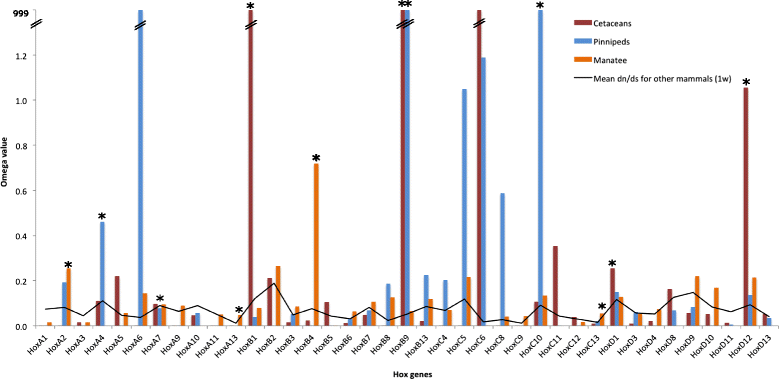Selection on different genes with equivalent functions: the convergence story told by Hox genes along the evolution of aquatic mammalian lineages
- PMID: 27209096
- PMCID: PMC4875654
- DOI: 10.1186/s12862-016-0682-4
Selection on different genes with equivalent functions: the convergence story told by Hox genes along the evolution of aquatic mammalian lineages
Abstract
Background: Convergent evolution has been a challenging topic for decades, being cetaceans, pinnipeds and sirenians textbook examples of three independent origins of equivalent phenotypes. These mammalian lineages acquired similar anatomical features correlated to an aquatic life, and remarkably differ from their terrestrial counterparts. Whether their molecular evolutionary history also involved similar genetic mechanisms underlying such morphological convergence nevertheless remained unknown. To test for the existence of convergent molecular signatures, we studied the molecular evolution of Hox genes in these three aquatic mammalian lineages, comparing their patterns to terrestrial mammals. Hox genes are transcription factors that play a pivotal role in specifying embryonic regional identity of nearly any bilateral animal, and are recognized major agents for diversification of body plans.
Results: We detected few signatures of positive selection on Hox genes across the three aquatic mammalian lineages and verified that purifying selection prevails in these sequences, as expected for pleiotropic genes. Genes found as being positively selected differ across the aquatic mammalian lineages, but we identified a substantial overlap of their developmental functions. Such pattern likely resides on the duplication history of Hox genes, which probably provided different possible evolutionary routes for achieving the same phenotypic solution.
Conclusions: Our results indicate that convergence occurred at a functional level of Hox genes along three independent origins of aquatic mammals. This conclusion reinforces the idea that different changes in developmental genes may lead to similar phenotypes, probably due to the redundancy provided by the participation of Hox paralogous genes in several developmental functions.
Keywords: Cetaceans; Hox genes; Molecular evolution; Pinnipeds; Positive selection; Sirenians.
Figures



Similar articles
-
Evolutionary changes of Hox genes and relevant regulatory factors provide novel insights into mammalian morphological modifications.Integr Zool. 2018 Jan;13(1):21-35. doi: 10.1111/1749-4877.12271. Integr Zool. 2018. PMID: 28685945 Free PMC article.
-
Hundreds of Genes Experienced Convergent Shifts in Selective Pressure in Marine Mammals.Mol Biol Evol. 2016 Sep;33(9):2182-92. doi: 10.1093/molbev/msw112. Epub 2016 Jun 21. Mol Biol Evol. 2016. PMID: 27329977 Free PMC article.
-
Convergent evolution of marine mammals is associated with distinct substitutions in common genes.Sci Rep. 2015 Nov 9;5:16550. doi: 10.1038/srep16550. Sci Rep. 2015. PMID: 26549748 Free PMC article.
-
The neocortex of cetaceans: cytoarchitecture and comparison with other aquatic and terrestrial species.Ann N Y Acad Sci. 2011 Apr;1225:47-58. doi: 10.1111/j.1749-6632.2011.05980.x. Ann N Y Acad Sci. 2011. PMID: 21534992 Review.
-
Hox gene evolution: multiple mechanisms contributing to evolutionary novelties.Ann N Y Acad Sci. 2012 May;1256:15-32. doi: 10.1111/j.1749-6632.2011.06385.x. Epub 2012 Feb 9. Ann N Y Acad Sci. 2012. PMID: 22320178 Review.
Cited by
-
Accelerated Evolution of Limb-Related Gene Hoxd11 in the Common Ancestor of Cetaceans and Ruminants (Cetruminantia).G3 (Bethesda). 2020 Feb 6;10(2):515-524. doi: 10.1534/g3.119.400512. G3 (Bethesda). 2020. PMID: 31792005 Free PMC article.
-
Relaxed selection in evolution of genes regulating limb development gives clue to variation in forelimb morphology of cetaceans and other mammals.Proc Biol Sci. 2024 Oct;291(2032):20241106. doi: 10.1098/rspb.2024.1106. Epub 2024 Oct 9. Proc Biol Sci. 2024. PMID: 39378996
-
Signatures of selection and environmental adaptation across the goat genome post-domestication.Genet Sel Evol. 2018 Nov 19;50(1):57. doi: 10.1186/s12711-018-0421-y. Genet Sel Evol. 2018. PMID: 30449276 Free PMC article.
-
Humerus shape evolved in cetaceans under relaxed selection and random drift.Commun Biol. 2025 Mar 29;8(1):518. doi: 10.1038/s42003-025-07952-w. Commun Biol. 2025. PMID: 40158047 Free PMC article.
-
Juxtapose: a gene-embedding approach for comparing co-expression networks.BMC Bioinformatics. 2021 Mar 16;22(1):125. doi: 10.1186/s12859-021-04055-1. BMC Bioinformatics. 2021. PMID: 33726666 Free PMC article.
References
-
- Berta A, Sumich JL, Kovacs KM. Marine Mammals Evolutionary Biology. 2. San Diego: Academic Press; 2006.
-
- Hoelzel AR. Marine mammal biology. An evolutionary approach. Cornwall: Blackwell Publishing; 2002.
-
- Uhen MD. The origin(s) of whales. Annu Rev Earth Planet Sci. 2010;38:189–219. doi: 10.1146/annurev-earth-040809-152453. - DOI
MeSH terms
Substances
LinkOut - more resources
Full Text Sources
Other Literature Sources

